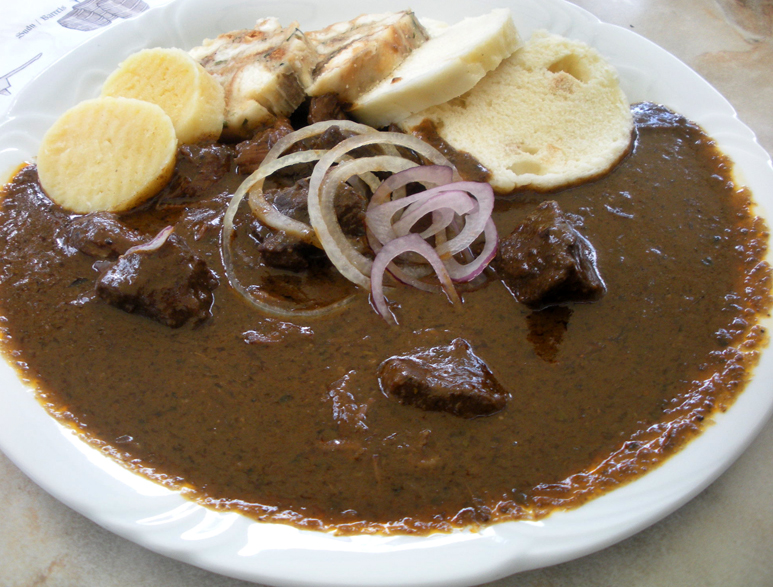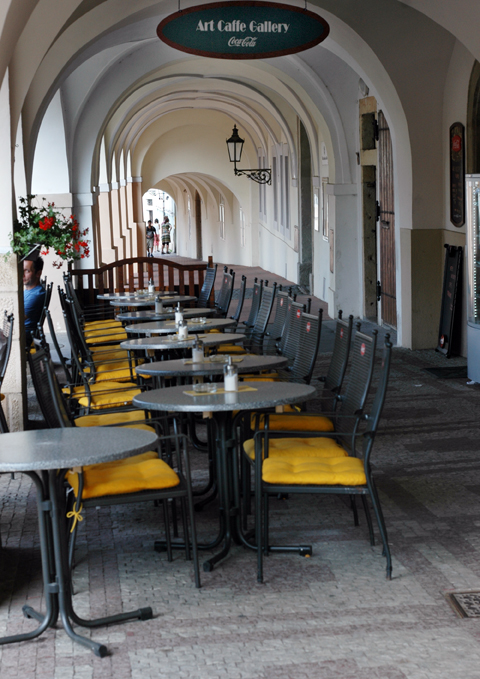Czech cuisine includes a comforting array of braised meats and stews, hearty dumplings, and cabbage. In fact, the Czech diet is heavily meat-centric, which can be challenging to the vegetarian traveler.
 Pork and beef, for instance, are greatly represented on Czech menus. Pork can be served numerous ways – from braised varieties in thick gravies, to goulash, to massive roasted knuckles and shanks; while beef is commonly roasted or marinated in beer. Typically, dumplings or braised cabbage will accompany the meat dishes. Knedlíky, boiled dumplings, are a Czech mainstay and can be ordered as a dish on their own for those less inclined to animal protein. These heavy, dense dumplings are usually bread based and sliced, differing from the smaller potato based varieties found in neighboring Germany and Austria. Cabbage can be either red or white, stewed or braised, and served as either sweet or sour versions.
Pork and beef, for instance, are greatly represented on Czech menus. Pork can be served numerous ways – from braised varieties in thick gravies, to goulash, to massive roasted knuckles and shanks; while beef is commonly roasted or marinated in beer. Typically, dumplings or braised cabbage will accompany the meat dishes. Knedlíky, boiled dumplings, are a Czech mainstay and can be ordered as a dish on their own for those less inclined to animal protein. These heavy, dense dumplings are usually bread based and sliced, differing from the smaller potato based varieties found in neighboring Germany and Austria. Cabbage can be either red or white, stewed or braised, and served as either sweet or sour versions.
 Given the Czech Republic’s cultural orientation to beer drinking, its not suprising that beer appears frequently as an ingredient in menu items; and that pub fare is popular at most eating establishments. Pivní sýr, a soft, spreadable cheese flavored with beer, for example, is often slathered on thick slices of brown bread. And, of course, potato pancakes (Bramboráky), sausages, and Smažený sýr (fried cheese) are all dishes typically consumed alongside a lager or two.
Given the Czech Republic’s cultural orientation to beer drinking, its not suprising that beer appears frequently as an ingredient in menu items; and that pub fare is popular at most eating establishments. Pivní sýr, a soft, spreadable cheese flavored with beer, for example, is often slathered on thick slices of brown bread. And, of course, potato pancakes (Bramboráky), sausages, and Smažený sýr (fried cheese) are all dishes typically consumed alongside a lager or two.
Beyond the fried and beer flavored varieties, extraordinarily fine cheeses often make appearances on Czech menus. Soft cheese, similar to Camembert, is typical and often marinated in oil with onions and peppers. Pungent, ripened cheeses like Olomoucké syrecky are popular and are served numerous ways – fried, marinated or added to potato pancakes.
There are countless restaurants and cafes serving traditional Czech cuisine in Prague, but the late crowds often congregate at Wenceslaus Square to frequent any number of fast food stalls. Open from morning until the wee hours of the night, these stalls serve up sliced sausages dipped in mustard and the ubiquitous Smažený sýr, though this version is sold between two hamburger buns with copious amounts of mayonnaise. The street foods are best enjoyed after one too many Czech beers, as the fried fare will surely help soak up some of the alcohol.
 Salads are common menu items at most Czech restaurants; often consisting of tomatoes, cucumbers and onions, seasoned with oil and/or mayonnaise. Bulgarian cheese, a salty cheese similar to feta, is often grated over salads. Salad portions are usually quite large, so vegetarian and vegan travelers can make main courses out of these items.
Salads are common menu items at most Czech restaurants; often consisting of tomatoes, cucumbers and onions, seasoned with oil and/or mayonnaise. Bulgarian cheese, a salty cheese similar to feta, is often grated over salads. Salad portions are usually quite large, so vegetarian and vegan travelers can make main courses out of these items.
Sweets are quite popular in the Czech Republic with the most common being sweetened dumplings filled with cream or fruits. Ovocné knedlíky are fruit dumplings, made most commonly with plums or apricots. Yeast based pastries are also highly regarded.
 Prague is, unquestionably, the perfect place to consume one’s way through the Czech cuisine, but travelers can also try various international offerings while in the capital city. As with many major European cities, there are an abundance of Italian restaurants serving their own national dishes as well as interpretations of Czech fare. Prague hosts a large Vietnamese immigrant population and consequently benefits from the culinary expertise of these residents. Other international restaurant offerings include: Greek, Mexican, Indian, Afghan, Chinese, and Georgian; all tucked away throughout the city.
Prague is, unquestionably, the perfect place to consume one’s way through the Czech cuisine, but travelers can also try various international offerings while in the capital city. As with many major European cities, there are an abundance of Italian restaurants serving their own national dishes as well as interpretations of Czech fare. Prague hosts a large Vietnamese immigrant population and consequently benefits from the culinary expertise of these residents. Other international restaurant offerings include: Greek, Mexican, Indian, Afghan, Chinese, and Georgian; all tucked away throughout the city.
When visiting Prague, sample a plate of braised pork with dumplings while drinking a pilsner; indulge in a fried cheese sandwich or two; snack on some traditional Czech desserts; and perhaps try a bowl of pho or pasta Bolognese.


Comments